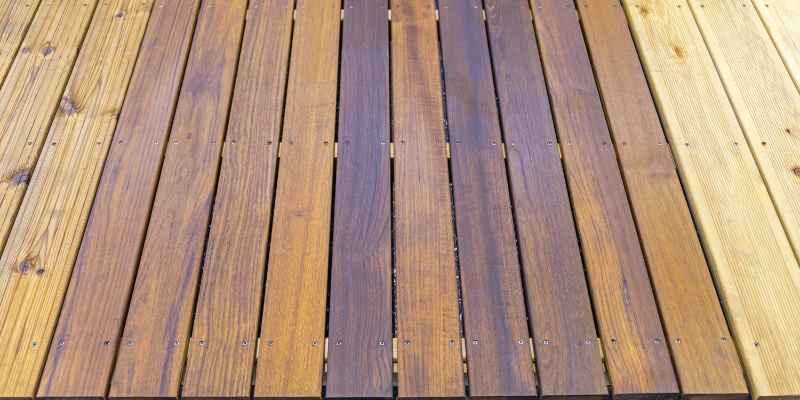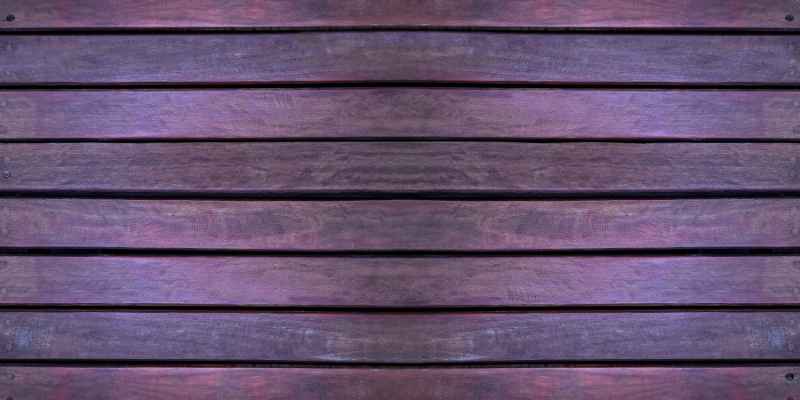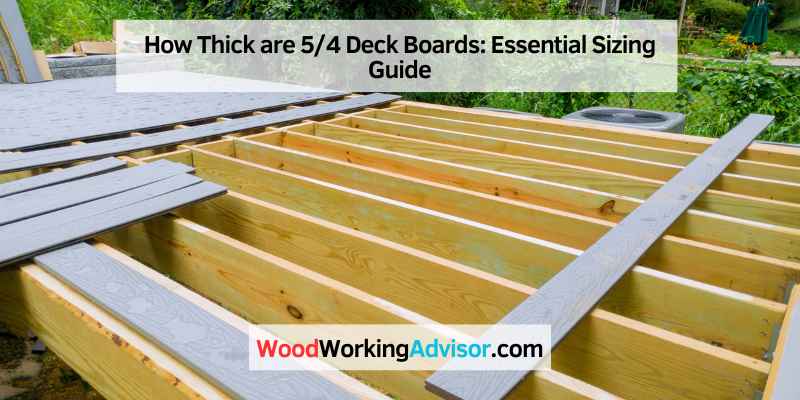5/4 deck boards are typically 1 inch thick. These boards are commonly used for decking projects and offer a sturdy and durable option for outdoor structures.
The thickness of the boards is an important consideration when planning and designing a deck, as it affects the overall strength and stability of the structure. By using 5/4 deck boards, you can ensure that your deck will be able to withstand the weight and pressure of foot traffic, furniture, and other elements.
Additionally, the thickness of the boards can also impact the appearance of the deck, providing a solid and substantial look.
Introduction To 5/4 Deck Boards
When it comes to building a deck, choosing the right materials is crucial for ensuring durability and longevity. One of the key decisions to make is selecting the appropriate deck board thickness. In this article, we will delve into the world of 5/4 deck boards, exploring their measurements and significance in deck construction.
Defining 5/4 Measurement
5/4 deck boards, often referred to as five-quarter boards, are a popular choice for decking projects. Despite the name, these boards are not actually 5/4 inches thick. Rather, they measure approximately 1 inch in thickness, making them slightly thicker than standard 1-inch boards.
Importance In Deck Construction
The thickness of 5/4 deck boards plays a critical role in the structural integrity and stability of the deck. Choosing the right board thickness is essential for supporting heavy foot traffic, outdoor furniture, and other loads. Thicker boards also offer improved resistance to warping, splitting, and other forms of wear and tear, enhancing the overall resilience of the deck.
Comparing Board Thicknesses
When it comes to building a deck, one of the most important decisions you’ll make is choosing the right board thickness. Deck boards come in a variety of sizes and thicknesses, and understanding the differences between them can help you make an informed decision. In this post, we’ll take a closer look at 5/4 deck boards and how they compare to other options.
Standard Deck Board Sizes
Deck boards are typically sold in standard sizes, with the most common being 2×6, 5/4×6, and 2×4. The first number in the size refers to the thickness, while the second number refers to the width. So, a 2×6 board is 1.5 inches thick and 5.5 inches wide.
5/4 Boards Versus Other Options
5/4 deck boards are a popular choice for many homeowners because they are thicker than standard 2×6 boards, making them more durable and able to support heavier loads. 5/4 boards are also available in a variety of widths, including 4”, 6”, 8”, and 10”.
Compared to 2×4 boards, which are only 1.5 inches thick, 5/4 boards are more durable and better able to withstand heavy foot traffic and furniture. However, they are also more expensive than 2×4 boards.
When compared to 2×6 boards, 5/4 boards are slightly thinner (1.25 inches versus 1.5 inches). However, because 5/4 boards are made from thicker material, they are still stronger and more durable than 2×6 boards.
Choosing the right board thickness for your deck can be a challenge, but understanding the differences between standard sizes and materials can help you make an informed decision. Whether you choose 5/4 boards or another option, make sure to select a board thickness that will provide the strength and durability you need for your deck.
Actual Dimensions Of 5/4 Deck Boards

5/4 deck boards are actually 1 inch thick, despite the name suggesting otherwise. This thickness provides durability and stability for your deck structure. It’s essential to consider this dimension when planning your deck design and construction.
Nominal Vs. Actual Measurements
When it comes to deck boards, it’s important to understand the difference between nominal and actual measurements. Nominal measurements are the dimensions that a piece of lumber is referred to as, such as 2×4 or 5/4. However, these measurements are not the actual dimensions of the board. Actual measurements are the true dimensions of the board after it has been planed and cut, which are typically smaller than the nominal measurements.
Common Misconceptions
One common misconception about 5/4 deck boards is that they are actually 5/4 of an inch thick. However, as mentioned earlier, the actual dimensions are smaller than the nominal measurements. In the case of 5/4 deck boards, the actual thickness is typically around 1 inch. This can be important to keep in mind when planning your deck project and selecting the appropriate size and spacing for your deck boards.
Another misconception is that thicker deck boards are always better. While thicker boards may be stronger, they can also be heavier and more expensive. It’s important to consider your specific project needs and budget when selecting the appropriate thickness for your deck boards.
Summary
In summary, 5/4 deck boards have a nominal thickness of 1-1/4 inches, but their actual thickness is typically around 1 inch. It’s important to understand the difference between nominal and actual measurements, as well as the potential drawbacks of selecting thicker deck boards. By considering these factors, you can make an informed decision about the best thickness for your deck project.
Material Considerations
5/4 deck boards typically measure around 1 inch thick, making them a sturdy choice for decking projects. When considering materials for your deck, keep in mind that the thickness of the boards can impact durability and overall stability of the structure.
Wood Types And Thickness
When it comes to choosing the right deck boards for your outdoor space, one of the key material considerations is the type of wood used and its thickness. Wood decks are a popular choice due to their natural beauty and durability. However, not all wood types are created equal, and the thickness of the deck boards can also vary.
There are several wood types commonly used for deck boards, each with its own unique characteristics. Some popular options include:
- Cedar: Known for its natural resistance to decay and insects, cedar is a popular choice for deck boards. It is available in various thicknesses, including 5/4 boards.
- Pressure-Treated Pine: Pressure-treated pine is a cost-effective option that offers resistance to rot and insects. It is also available in different thicknesses, including 5/4 boards.
- Tropical Hardwoods: Tropical hardwoods like ipe and mahogany are known for their exceptional durability and resistance to rot and insects. These woods are typically available in thicker board options.
The thickness of the deck boards is an important consideration as it affects the strength and stability of your deck. The most common thickness for deck boards is 5/4, which refers to a thickness of 1 ¼ inches. This thickness provides a sturdy and stable surface for your deck, capable of withstanding heavy foot traffic and outdoor elements.
Composite Materials And Durability
If you’re looking for an alternative to traditional wood deck boards, composite materials can be a great choice. Composite decking is made from a combination of wood fibers and recycled plastic, offering a durable and low-maintenance option.
Composite deck boards come in various thicknesses, typically ranging from 1 to 1 ¼ inches. The thickness of the boards can affect their durability and resistance to warping or sagging over time. Thicker composite boards tend to be more rigid and less prone to bending or flexing under weight.
It’s important to note that composite deck boards may have different installation requirements compared to wood boards. Always refer to the manufacturer’s guidelines for proper installation and spacing.
In conclusion, when considering the material for your deck boards, take into account the type of wood or composite material used and its thickness. This will ensure you choose a deck that not only looks great but also provides the durability and strength you need for your outdoor space.
Impact On Deck Design
When considering deck design, the thickness of 5/4 deck boards has a significant impact. From structural implications to aesthetic influence, the choice of deck board thickness plays a crucial role in the overall design and functionality of the outdoor space.
Structural Implications
Structural Implications
The thickness of 5/4 deck boards directly affects the structural integrity of the deck. Thicker boards provide greater strength and stability, especially for elevated decks or those supporting heavy furniture and foot traffic. It’s important to consider the load-bearing capacity and span requirements when choosing the appropriate board thickness to ensure the structural safety and longevity of the deck.
Aesthetic Influence
Deck board thickness contributes to the visual appeal and overall aesthetic of the deck. Thicker boards can create a more substantial and robust appearance, adding a sense of durability and luxury to the outdoor space. Additionally, the choice of board thickness can impact the overall design style, such as contemporary, traditional, or rustic, offering versatility in achieving the desired aesthetic for the deck.
Installation Tips For 5/4 Boards
When it comes to installing 5/4 deck boards, there are some important factors to consider to ensure a successful and long-lasting deck. From spacing requirements to fastening techniques, here are some essential tips to keep in mind.
Spacing Requirements
Proper spacing is crucial to allow for the natural expansion and contraction of the deck boards. The general rule of thumb is to leave a 1/8-inch gap between the boards to accommodate for this movement. This gap helps prevent warping and buckling, ensuring a stable and durable deck surface.
Fastening Techniques
When fastening 5/4 deck boards, it’s important to use the appropriate fasteners to secure the boards firmly in place. Stainless steel or coated screws are recommended for fastening the boards, as they offer corrosion resistance and durability. Additionally, using a hidden fastening system can provide a clean and seamless look, eliminating visible screws and nails on the surface of the deck.
Maintenance And Longevity
5/4 deck boards typically measure 1 inch in thickness, providing durability for long-term use. Regular maintenance can further extend their lifespan, ensuring a sturdy and reliable outdoor decking solution.
Preserving Board Thickness
Regular cleaning and sealing preserve the board thickness.
Seasonal Care For Deck Boards
Protect boards from moisture during rainy seasons.
Choosing The Right Boards For Your Deck
5/4 deck boards typically measure 1 inch thick and 5. 5 inches wide, offering strength and durability for your deck. Choosing the right boards is crucial for a sturdy and long-lasting outdoor space. Consider the thickness and material to ensure your deck can withstand the elements and heavy foot traffic.
Factors To Consider
When choosing deck boards, consider factors like material, thickness, and durability.
Ensure the boards can withstand your local climate conditions and maintenance requirements.
Cost Vs. Quality
Balance cost and quality by selecting boards that offer longevity without breaking the budget.
Quality boards may have a higher upfront cost but can save money in the long run with less maintenance.

Frequently Asked Questions
How Thick Should Deck Boards Be?
Deck boards should typically be at least 1 inch thick. However, for optimal strength and durability, it is recommended to use boards that are 5/4 inches thick. This thickness provides better support and reduces the risk of warping or sagging over time.
How Thick Is 5 4 Wood?
5/4 wood is typically 1 inch thick.
How Far Can 5’4″ Deck Boards Span?
The maximum span for 5’4″ deck boards depends on the type of wood, spacing, and joist size. As a general rule, the maximum span for 5’4″ deck boards is around 16 inches on center for residential applications. However, it’s always best to check with local building codes and regulations to ensure compliance and safety.
Why Is Deck Board 5 4?
Deck boards are labeled as 5/4 due to the way they are milled. The “5/4” measurement refers to the rough size before planing.
Conclusion
Understanding the thickness of 5/4 deck boards is crucial for a successful deck installation. These boards, with a thickness of approximately 1 inch, offer durability and strength for outdoor spaces. By considering factors such as joist spacing and load requirements, you can confidently choose the right deck board size for your project.
Remember to consult industry guidelines and seek professional advice when needed. With this knowledge, you can create a beautiful and sturdy deck that will withstand the test of time.

